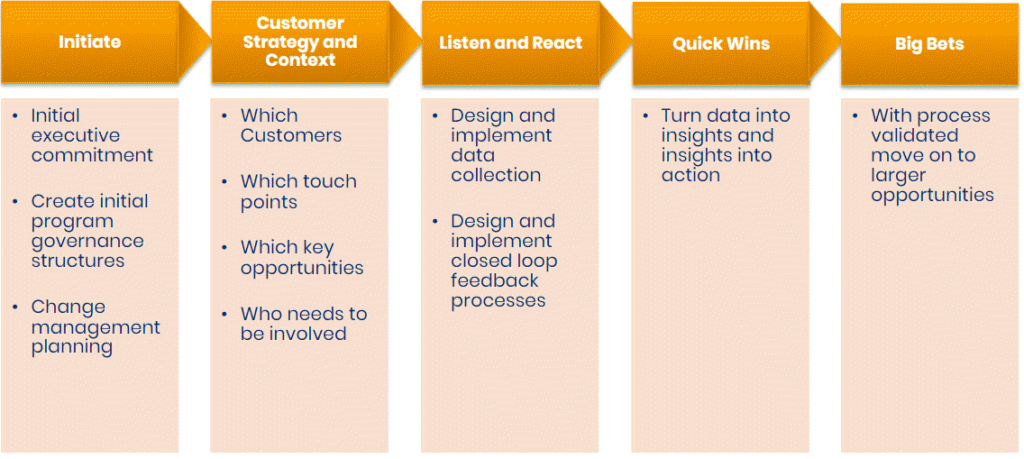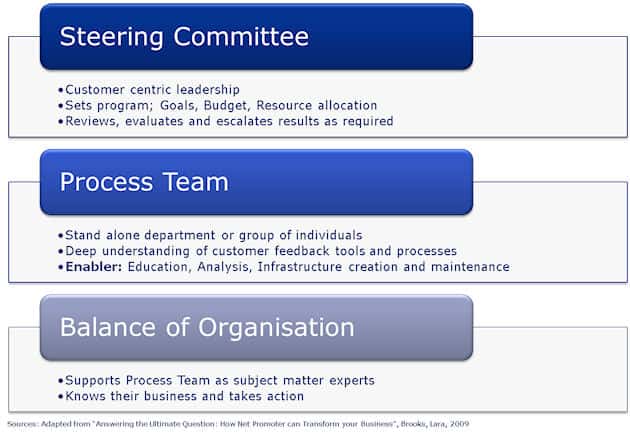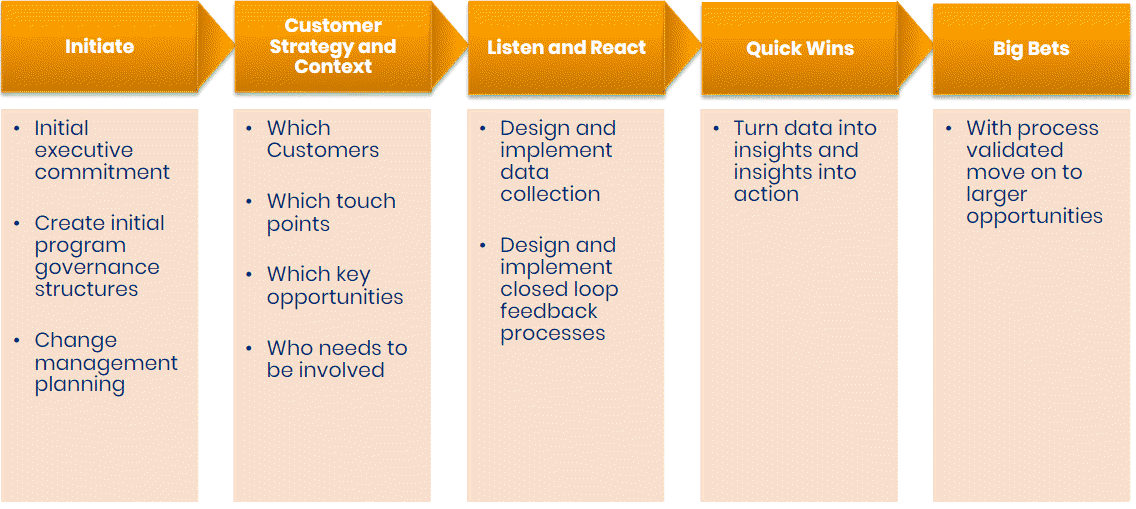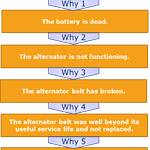You’ve heard about it, you’ve researched it, and you like what you hear.
Properly implementing Net Promoter Score in your organisation will yield powerful business results. But between wanting and doing, there are key steps that need to happen for you to be successful.
The first critical thing you need to know is that NPS® is not a metric, it is a process.
Adding the “Would Recommend” question to your current customer survey or emailing a SurveyMonkey survey to all of your customers is not implementing Net Promoter Score.
Just measuring NPS will not drive business value: you have to put in place a process to measure, understand and make change, to capture the benefits of NPS.
In this post I review the process we have tested and refined over 15 years of NPS consulting for our clients. It works.
- Step 1. Get Buy In for NPS From The Organisation
- Step 2. Map The Customer Journey to Prioritise Customer Segments & Touch-Points
- Step 3. Design The Survey & Data Collection Process
- Step 4. Close the Loop With Customers
- Step 5. Identify and Execute on some Quick, Impactful Business Improvements
- Step 6. Deeper Analysis to Drive Big Changes
- Step 7. Repeat: the Listen, Analyse, Act Loop

Step 1. Get Buy In for NPS From The Organisation
The Initiate phase of NPS implementation is all about:
- Ensuring senior executives are engaged and committed
- You have the right internal structures (Governance) to make effective use of the information
- Launching the process effectively to all staff so you have broad buy in.
Use the that first wave of energy part to get everybody engaged in the process.
We know from experience that if you do not get the process Initiated correctly, with the right corporate systems in place, it will fail. Generally it takes 12-24 months but it will fail.
There are three elements to this step:
Gain Executive Commitment For NPS Implementation
Implementing an NPS program takes time, effort and money.
Staff will have to re-prioritise what they are doing so you should start by ensuring you have good support up through all levels of the organisation.
Here are some questions you can ask the senior management team to dig deeper into their commitment to NPS implementation.
- You about to invest substantial resources and time in rolling out Net Promoter: Why?
- Will there be a Steering Committee to manage corporate oversight?
- What will it’s charter be?
- Will you have an NPS process team focused on carrying out the day to day task of using the feedback to improve the business or will you devolve that to the operating units?
- How will these groups operate?
- Who will be in them?
Create the NPS Governance Process
Critical to success is a Net Promoter governance process for your organisation. Governance frameworks can be boring and nobody really wants to talk about them but is it the place that we find many organisations have failed in their NPS launch.
This is the governance model that we use with organisations and it has proven to be very effective. Learn more about the details of the Net Promoter Governance Model.

Design the NPS Change Management Plan
Implementing Net Promoter is a big change for most organisations and it needs to be communicated effectively. You cannot leave this to chance.
The Process team should lead the change management process as they are most intimately involved and have the deepest understanding. They should consider who will be impacted upon by the rollout of the process and who will have the most impact on the success of the implementation.
Then a communication plan should be created to address the needs and concerns of each group of staff.
Some organisations choose to create an internal brand for the Net Promoter program and it can be a very effective tactic. The branding process serves as a way to bring all of the communication together into an effective package.
Step 2. Map The Customer Journey to Prioritise Customer Segments & Touch-Points
Now you need to turn your focus to your customers.
When you implement a comprehensive Net Promoter program you can do it in two ways:
- Big Bang – roll the whole program out at once. This is a high risk approach with a long planning and lead time.
- Incrementally – rollout the Listen phase to selected touch points. Then as you grow in experience and get some runs on the board you can extend the range of touch points.
This second approach is our recommendation and the Customer Strategy and Context allows you to prioritise that rollout process.
In this phase you should create Touchpoint or Customer Journey Maps of your customer experience. This will allow you to prioritise the launch and focus on the most important areas first:
Which Customers – are most important
Prioritise your customer segments so the more important segments are implemented before less important segments. This prioritisation can be strategic, or by value or some other key variable in your business.
Which Touchpoints– should you measure
For each of your key customer groups create a Touchpoint map that covers their interaction with you from awareness to exit.
Which Opportunities – present the best value
NPS implementation must be focused on driving business value so it makes sense to identify the high value opportunities for improvement in your NPS and business and then attack them first.
Do you have a poorly performing product line or a contact centre that is constantly having issues?
Think about where you can take action for the maximum effect.
Who needs to be involved – to ensure success
Make sure that you have the right people in the room for these Touchpoint mapping discussions. You should have people who understand the process (of course) but also people who understand the data systems. The data system folks will help you to identify what data is captured and available for use in data collection automation.
Step 3. Design The Survey & Data Collection Process
Only now do you get down to the business of survey design and implementing your data collection process.
Of course with the Net Promoter Score process part of the survey design process is very straightforward: the NPS question forms the heart of the survey.

However, you will still need to look at survey design to gain insights into what is important for your customers.
Understanding what drives the Net Promoter Score is as important as the score itself. If you just collect the NPS and do not collect any supporting data to understand what drives it you are mostly wasting your time.
The data collection process is not trivial either. If you are running a transactional NPS process then you will need to be able to collect, analyse and act on feedback data every day, day and day out.
Which NPS data collection system will you use and how will you get data in and insights out?
Step 4. Close the Loop With Customers
If implementing transactional NPS then you have a very powerful customer loyalty opportunity from day one: Service Recovery.
Service recovery, or reaching out to unhappy customers and making them happy, is an incredibly powerful way to generate customer loyalty. So you should ensure you have a solid service recovery system in place when you start your transactional survey process.
Soon after you have started sending surveys you should consciously design your service recovery process.
Run a closing the NPS loop design workshop and make sure that the key staff are involved, including the Process team.
In the workshop you should address key questions including:
- How will the organisation be alerted to low scores? – In practice what will happen, exactly.
- Who should action them? – Will they be triaged (one person receives all the issue and manually sends them to the right person) or will be automatically distributed around the organisation based on a set of rules. What are the rules?
- How will the actions be tracked?
- What reporting is required?
- What is the process flow?
- How quickly and how will you respond to clients?
When the workshop is over make sure you document the new process so that you can act quickly and effectively on the responses from customers.
Step 5. Identify and Execute on some Quick, Impactful Business Improvements
Okay, so you have everything up and running and you’re collecting data, now what?
Now you need to show some quick wins to demonstrate some payback for all of the effort so far.
Rather than trying for a big bang win that may be high risk or long term, look for some quick wins that will get runs on the board right now.
Can you change a call centre script to give customers more of the information they need?
Can you change a website form to make it easier to understand?
If you can and you can show uplift in your NPS score you have the makings of a great quick win.
If you can link it to higher conversation rates, revenue, gross margin or profit, even better. Incidentally if you are using transactional NPS then you will find these quick wins very quickly. Almost every one of our customers that have implemented transactional NPS have found quick wins within days of starting to collect data.
Step 6. Deeper Analysis to Drive Big Changes
When you have been running to data collection process for 6-12 months and you have made quite a few small changes you will be more confident in the data and in your analysis. This is the time to look for some Big Bets.
Big Bets generally need detailed costing, ROI analysis and senior management approval so they take time to identify and plan. However they are where you can make big impacts on the NPS and therefore customer loyalty
Examples of Big Bets include redesigning products, adding significant functionality to existing products and making large organisation changes.
These are changes not to be taken lightly but if you have proven the value of the Net Promoter process through a range of Quick Wins then you will be in a good position prove your case.
Step 7. Repeat: the Listen, Analyse, Act Loop
Now that you have the basic process down you simply need to repeat the listen, analyse, act loop. Remember this is not a project with a beginning, middle and end. It’s a never ending story of continuous improvement.
Get the Business Leader's Guide to Net Promoter Score Download Here









